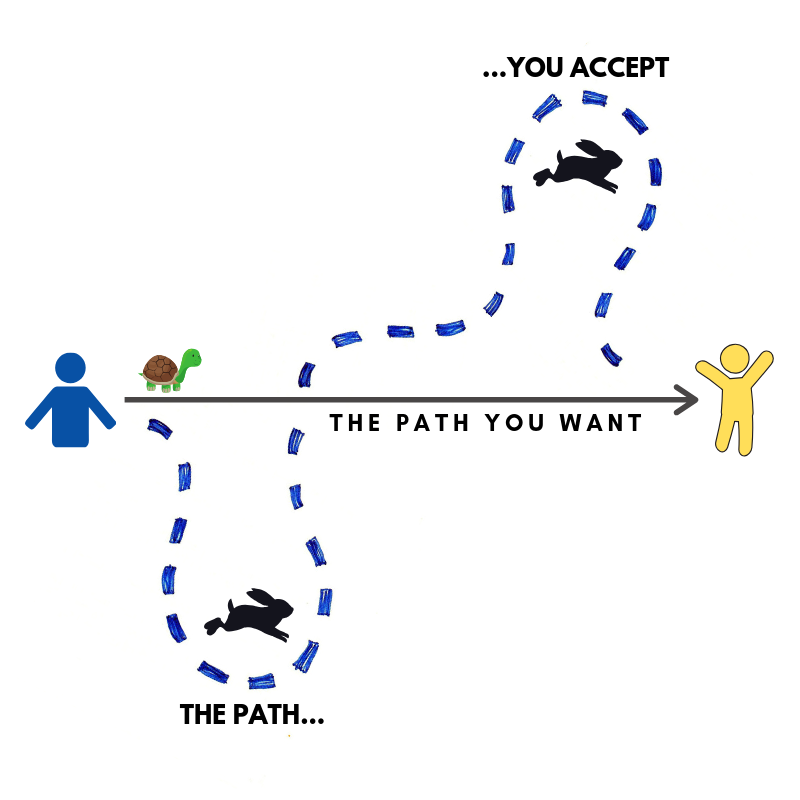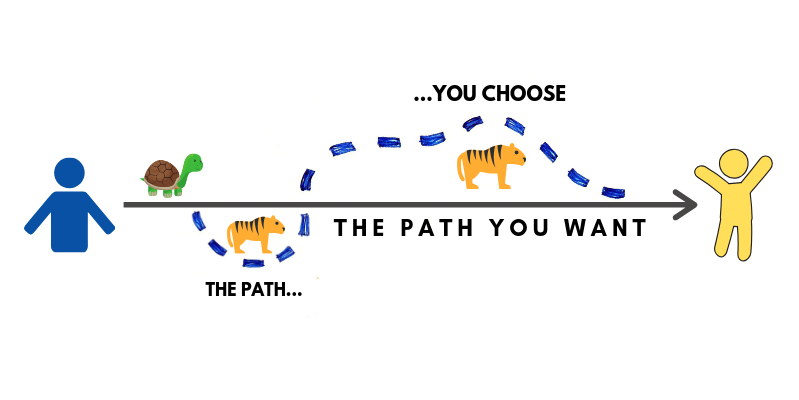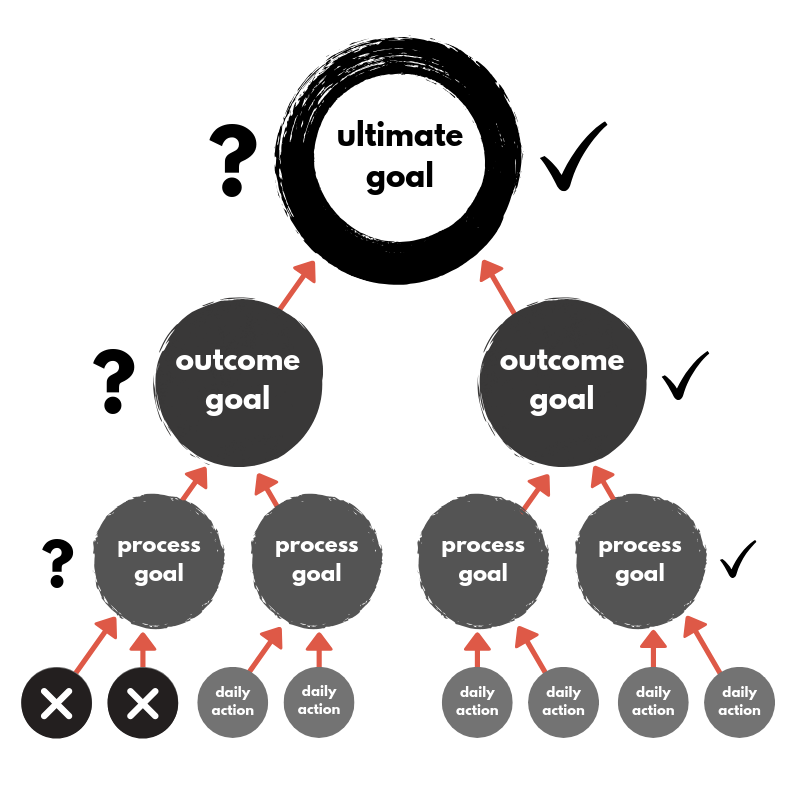We’ve all heard the classic story of the Tortoise and the Hare. If you haven’t, here’s my brief synopsis: A cocky little hare wants to challenge an old sage tortoise to a foot race. The race starts and as one would expect the Hare blasts off way ahead leaving the tortoise in the dust. Seeing how far ahead he is, the arrogant Hare is so confident he’s going to win that he just lays down and takes a quick 10. Upon being woken by the thunderous cheers, the Hare realizes the Hare has passed him and is about to cross the finish line. He bolts to his feet but it’s too late. The slow and steady tortoise won the race.

It’s a valuable story and I think it teaches a great lesson about the pitfalls of arrogance and how our ego can hurt us in the long run. To me, the tortoise serves as a great symbol for what it looks like when we set a goal, stay committed to the course, and reach our final destination. However, I just have a few problems with this:
- Nobody ever stays perfectly on course
- We need to make mistakes to learn and grow
- And life doesn’t move that slow
I mean let’s face it, as athletes we can’t just go through a competition in a slow and steady manner. Heck no! We’d get beat on every play and sitting on the bench before we knew what hit us. It just doesn’t work like that. We have to read, react, and move all in a matter of a split second. There is no room for a tortoise mentality in the life of an athlete.
So here is what I propose instead. We shouldn’t aim to be like the Hare because nobody needs that much speed and that little brain power. And we can’t live like a tortoise because then we’d never get anything done, and we’d be a real liability on defense. But perhaps there is a nice middle ground animal that we can find to give us a better story.
Based on what I’ve been able to discover on Wikipedia, Hare’s are the 7th fastest land animal on the planet and they max out around 80 km/h (50 mph). But let’s be real here, that’s just too dang fast to be making any rational decisions. But what if we bring things down to 64 km/h with the Tiger?
Yeah, they aren’t going to be leading the pack, but at that speed, they can actually think clearly and perform at a relatively consistent level. Now…
- Are they going to make mistakes? Yes
- Will they get a little ahead of themselves at times? Probably
- Are they susceptible to laziness? Occasionally
- (Is this the perfect analogy? No, but just go with)
- But, are they going to go so far off course that they can’t recover? Never!
For all my visual learners out there, below is a little illustration to demonstrate what I mean by all of this and how it applies to our lives.

We will always have the ideal path in life. This is the “Path You Want” and it’s the one we would follow if it meant we could go at the pace of the tortoise. But in our athletic routines and in our daily lives we are very susceptible to becoming a product of the “Path You Accept”.
Path You Accept
- Being Reactive
- Succumbing to Negative Emotions
- Extrinsic Motivation
- Seeking Comfort
- “Just Showing Up”
When we choose to follow this path, we choose to act without thinking. We just start running ahead as fast as we can hoping that we are staying on track. Then somewhere along the way, we realize we made a wrong turn (i.e. play a terrible game, ruin a friendship, or have an epiphany) and we come back to the ideal path. Then a short while later, we start to deviate again, and we get so far away from our ideal path that it takes us even longer to get back this time. We have to override some bad habits, remember what’s important, and do a complete reassessment of what we need to work on.
Going off course is a natural part of life. Nobody is perfect. But when we start to go so far away from the ideal it can take us weeks to realize it and even more time to recover. Now we’ve lost all that time we could have been steadily improving, and we can’t get that back. It’s gone forever.
And so once again I propose the mindset and pace of the Tiger. I suggest rather than going so fast we can’t see what’s happening that we find a nice middle ground with the “Path You Choose”.

Path You Choose:
- Responding rationally
- Being Consistent (in all behaviour)
- Intrinsic Motivation
- Seeking Challenges
- Restarting Fresh Each Day
This quote by Russ Harris, sums all of this up quite nicely:
“Commitment isn’t about being perfect, always following through, or never going astray. Commitment means that when you (inevitably) stumble or get off track, you pick yourself up, find your bearings, and carry on in the direction you want to go.”
― Russ Harris
Being committed to the path you want
Commitment: That’s what this all really comes down to doesn’t it?
The challenge, however, is that for many of us we’ve been an athlete for so long that we’ve forgotten what we even committed to. And when our bodies are weak, our mind is fragile, and we begin to ask ourselves, why am I even doing this? — we don’t really have a good response.
Why am I doing this?It’s a great question. Why would you push yourself and experience the levels of suffering required for growth if it wasn’t serving some ultimate purpose? The rational thing to do would be to quit.

Yet deep down, very few of us are ready to throw in the towel. We didn’t get here by giving up when things got a little challenging. No, we gritted our teeth, focused, and found a way to make it through.
“For the past 33 years, I have looked in the mirror every morning and asked myself: ‘If today were the last day of my life, would I want to do what I am about to do today?’ And whenever the answer has been ‘No’ for too many days in a row, I know I need to change something.”
– Steve Jobs
We have to look in the mirror every day and remind ourselves of what we want to accomplish and more importantly, the type of character we will show throughout. It’s not enough to just set goals. We need to know how to achieve them in a way that does not compromise the integrity of our character.
This is why I fundamentally believe every athlete needs to start with establishing their values and priorities before they get anywhere near goal setting. Because if you don’t know what you stand for you’ll fall for anything. And when the doubt creeps in or tough choices come our way we won’t know what to do and will end up making a choice we later regret.
How to stay committed
There are a number of different steps involved in setting our minds on The Path We Want. Nuances arise from person to person and it can take some serious soul searching to figure out where you’re going to find the most meaning. But from my experience it mostly comes down to being able to properly answer 4 questions:
- What do you value?
- Where are you going?
- What are the landmarks along the way?
- What can you accomplish today that will move you forward?
Each of these questions are fairly straightforward but being able to answer them clearly and definitively is one of the surest ways to establish what you are committed to. To get a little more detailed, here is why each one is so vital to answer:
// What do you value?
Our personal values are something we bring with us everywhere we go. They are what we hold to in our darkest times and in our greatest moments. They even help us get through things we don’t want to do because they remind us of our priorities.
For example: I don’t love to do the dishes, but I know that my wife cares about having a cleanly home. And since I love my wife and want to be an equally contributing member to the relationship I get the dishes done.

// Where are you going?
Many people have ideas of what a successful, meaningful, or ideal future will look like, but they really don’t have anything that is tangible and specific. We want to be clear about exactly where we want to be so that we can know if we are on track.
A vision is what guides you. A vision is about what you’re here to create. It’s the reward at the end of the tunnel. And the more real and vivid we can make it, the more likely we are to stick with it and persist.
And don’t get me wrong, goals are important, but they are not the driving force. They are simply the landmarks along the way to our life vision.
// What are the landmarks along the way?
To reach a vision we need to know if we are on the right track. This is why goal setting is so important. But very few of us think about setting goals as steps towards a grander vision. We feel like if we set a goal, work towards it, and then achieve it that suddenly life will be meaningful and complete. But this is just the opposite of what happens when we view achievements in this way (a hard lesson Kevin Durant had to learn).
Rather we should view our goals as systems. Ways of thinking and striving that move us towards our vision regardless if we are perfect in our success rate.
To accomplish setting up a goal “system” it’s best to create 3 levels of goals:
- Ultimate Goals: How you do you want to be remembered? (i.e. Legacy)
- Outcome Goals: Measurable achievements towards the ultimate goal
- Process Goals: What it takes to achieve your outcome goals?
// What can you accomplish today that will move you forward?
To me, answering this question is one the most essential parts of what it means to be a Daily Athlete. Looking back on my athletic career it’s a question I wish I considered way more often than I did. From my personal experience, I believe it’s imperative we give meaning to the small tasks, interactions, and opportunities we are presented with on a moment-by-moment basis if we want to have any chance of reaching our full potential.
There are multiple ways to bring this thinking into the forefront of our mind. But one of the most reliable, practical, simple, and self-regulating ways we can do so is through a journal. You can keep it simple, get crazy, or just write until your hand falls off. But there are two primary questions that you should be asking yourself daily:
- Beginning of the day: What actions, tasks, or duties will move me towards my goals today?
- End of the day: What happened today (good or bad) and how can I be better next time?
To say that following these steps will solve all your problems and give you an exact path to follow would be a huge overstatement. Nevertheless, if you are able to just confidently answer these four questions, you’ll have a few more tools in the toolbelt and be a little bit clearer on what exactly it is going to take to achieve the things you want.
The Tortoise, the Hare, and the Tiger
We all have times in our lives where we get off track. We have a plan (like the tortoise), which is full of good habits and intentions, but then we deviate. We give into weak mindsets, forget what we’re aiming for, and we start to drift away from the person we want to be (just like the Hare).
The problem is, these changes aren’t always obvious. They are slow adaptations that take shape day-by-day. And it’s not until a week, or a month or even a year passes before we realize just how far we’ve gone off course and snap back into a better mindset.
By asking yourself these questions and digging deeper into your life’s purpose, you give yourself a guide on a daily basis. And with something like a daily journaling practice, we can continuously check in with ourselves to make sure we haven’t gone too far off course (like the tiger).
“If one does not know to which port one is sailing, no wind is favorable.”
— Seneca
Here’s the thing, it’s impossible to not have bad days and to drift off course. But we should do our best to apply habits and mindsets that reduce the chances of that occurring.
Doing this practice every single day might seem small on its own, but it’s the accumulation of small actions done well, day after day, that ultimately leads to greatness.
-Derek
P.S. – Is this article hitting you to the core? Do you feel like your athletic career is lacking any sort of serious commitment? Or are you simply wanting to avoid the path of the Hare before it’s too late? Then consider checking out a few of the resources I offer here at Daily A







